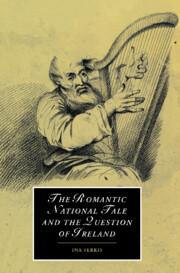Book contents
- Frontmatter
- Contents
- Acknowledgments
- Introduction: the awkward space of Union
- 1 Civic travels: the Irish tour and the new United Kingdom
- 2 Public address: the national tale and the pragmatics of sympathy
- 3 Female agents: rewriting the national heroine in Morgan's later fiction
- 4 The shudder of history: Irish Gothic and ruin writing
- 5 Agitated bodies: the Emancipation debate and novels of insurgency in the 1820s
- Notes
- Bibliography
- Index
- CAMBRIDGE STUDIES IN ROMANTICISM
3 - Female agents: rewriting the national heroine in Morgan's later fiction
Published online by Cambridge University Press: 22 September 2009
- Frontmatter
- Contents
- Acknowledgments
- Introduction: the awkward space of Union
- 1 Civic travels: the Irish tour and the new United Kingdom
- 2 Public address: the national tale and the pragmatics of sympathy
- 3 Female agents: rewriting the national heroine in Morgan's later fiction
- 4 The shudder of history: Irish Gothic and ruin writing
- 5 Agitated bodies: the Emancipation debate and novels of insurgency in the 1820s
- Notes
- Bibliography
- Index
- CAMBRIDGE STUDIES IN ROMANTICISM
Summary
it is the peculiar advantage of woman's interference, that its sphere of action is all-pervading, and that its applicability commences there where all other agencies have no prise or lever to act upon.
Lady Morgan The Princess (1835)a scene got up is always well worth a case stated.
Lady Morgan The O'Briens and the O'Flahertys (1827)“Politics can never be a woman's science,” Morgan declared early in her career, “but patriotism must naturally be a woman's sentiment.” What made patriotism “naturally” a sentiment for Morgan, as for her compatriot Edmund Burke, was its roots in the intimate sphere of the local and domestic. Domestic affections expanded into “sentiments of national affection,” establishing a national-cultural whole in which forms of public subjectivity were not only continuous with but grew out of the private sphere of the conjugal family. But even as Morgan continued to authorize her writing in terms of an acceptable “female patriotism” throughout her career (as in the preface to her last Irish tale The O'Briens and the O'Flahertys), her national tales increasingly began to interrogate the smooth flow from private to public implied by this model, troubling rather than consolidating the domestic articulation of women and nation rapidly, if not always straightforwardly, achieving prominence in post-Revolutionary Britain.
- Type
- Chapter
- Information
- The Romantic National Tale and the Question of Ireland , pp. 74 - 101Publisher: Cambridge University PressPrint publication year: 2002



